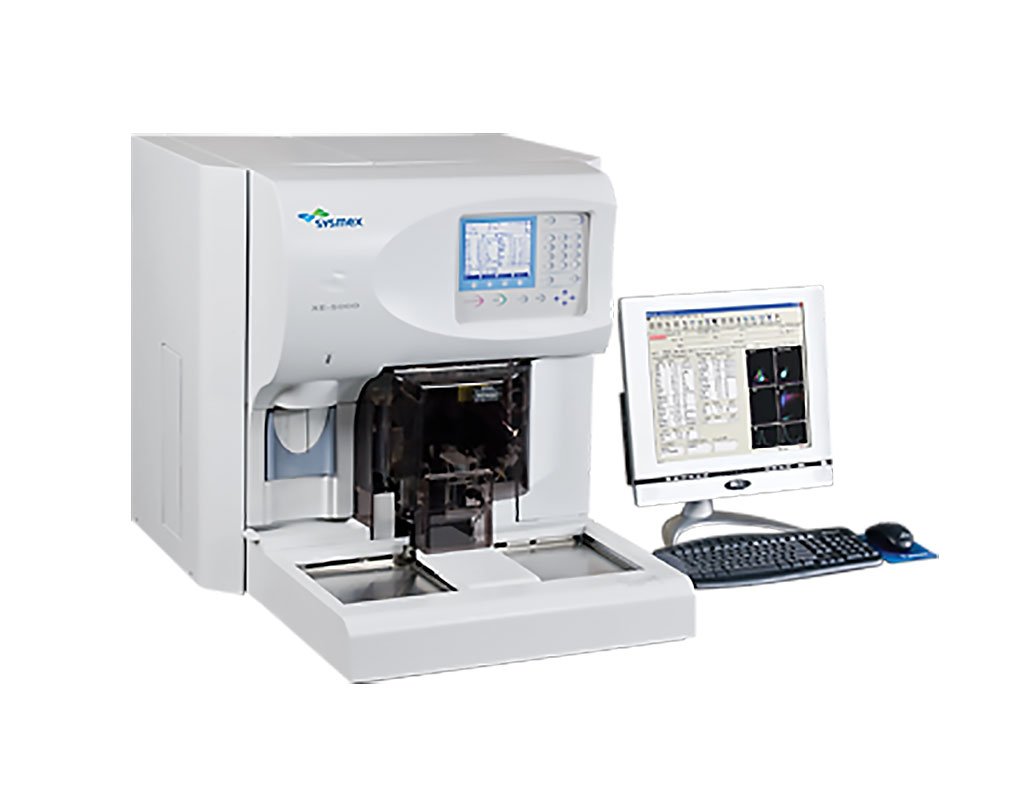Prognostic Values of Platelet Parameters in Gynecological Tumors Patients
|
By LabMedica International staff writers Posted on 24 Mar 2020 |

Image: The XE-5000 Hematology Analyzer is a high volume analyzer that offers unique clinical parameters to aid in better patient care (Photo courtesy of Sysmex Corporation).
Gynecologic cancers often involve the uterus, ovaries, cervix, vulva, vagina, fallopian tubes, or the peritoneum. The most common gynecologic cancer in the USA is endometrial cancer, followed by ovarian cancer. Many gynecologic cancers manifest as pelvic masses.
Platelets are small, hematopoietic, and anucleate cells released by bone marrow megakaryocytes in the bloodstream, and were described as the major effectors of several physiological and pathophysiological processes, such as hemostasis, thrombosis, immunological defense mechanisms, and the development of inflammation.
Medical Laboratory Scientists at the Wenzhou Medical University (Wenzhou, China) included in a study a total of 1,062 women who underwent gynecological tumor surgery for the first time between January 2014 and February 2016. Platelet parameters were recorded on the basis of the first complete blood count (CBC) within two weeks before surgery.
Differences of platelet parameters (platelet count [PLT], plateletcrit [PCT], mean platelet volume [MPV], platelet‐large cell rate [P‐LCR], and platelet distribution width [PDW]) between different categories were analyzed by nonparametric test. Venous blood was drawn from patients after admission which would transport to the laboratory within one hour and measured by Sysmex XE5000 hematology analyzer (Sysmex Corporation, Kobe, Japan). All microscopic slides and immunohistochemistry of tissue excised intraoperatively were reviewed by two pathologists. Computed tomography (CT) scan and lymph node metastasis sites were used to detect metastatic status.
The investigators reported that the platelet count and PCT were significantly increased, and MPV and P‐LCR were significantly reduced in malign and benign gynecological tumor groups compared with the controls; PDW had no significant differences. There were no significant differences in PLT, PCT, MPV, P‐LCR, and PDW between different tumor locations and pathologic types. The optimal cutoff values of PLT, PCT, MPV and P‐LCR were 274, 0.26, 10.08, and 24.8 (AUC: 0.661, 0.643, 0.593, 0.562), and PCT had preferable sensibility and specificity (50.8% and 70.4%) in predicting the presence of gynecological tumors. According to survival analysis, increased PLT (≥274 × 109/L) and PCT (≥0.26), and induced MPV (<10.08 fL) and P‐LCR (<24.8%) were associated with shorter overall survival.
The authors concluded that the increased PLT and the decreased platelet volume were not only common in gynecological cancer, but also usual in gynecological benign tumors. PLT, PCT, MPV, and P‐LCR were useful auxiliary parameters for predicting the presence of gynecological tumor. In addition, increased PLT and PCT, or decreased MPV and P‐LCR indicated a heavier tumor burden and shorter overall survival. The study was published on March 13, 2020 in the Journal of Clinical Laboratory Analysis.
Related Links:
Wenzhou Medical University
Sysmex Corporation
Platelets are small, hematopoietic, and anucleate cells released by bone marrow megakaryocytes in the bloodstream, and were described as the major effectors of several physiological and pathophysiological processes, such as hemostasis, thrombosis, immunological defense mechanisms, and the development of inflammation.
Medical Laboratory Scientists at the Wenzhou Medical University (Wenzhou, China) included in a study a total of 1,062 women who underwent gynecological tumor surgery for the first time between January 2014 and February 2016. Platelet parameters were recorded on the basis of the first complete blood count (CBC) within two weeks before surgery.
Differences of platelet parameters (platelet count [PLT], plateletcrit [PCT], mean platelet volume [MPV], platelet‐large cell rate [P‐LCR], and platelet distribution width [PDW]) between different categories were analyzed by nonparametric test. Venous blood was drawn from patients after admission which would transport to the laboratory within one hour and measured by Sysmex XE5000 hematology analyzer (Sysmex Corporation, Kobe, Japan). All microscopic slides and immunohistochemistry of tissue excised intraoperatively were reviewed by two pathologists. Computed tomography (CT) scan and lymph node metastasis sites were used to detect metastatic status.
The investigators reported that the platelet count and PCT were significantly increased, and MPV and P‐LCR were significantly reduced in malign and benign gynecological tumor groups compared with the controls; PDW had no significant differences. There were no significant differences in PLT, PCT, MPV, P‐LCR, and PDW between different tumor locations and pathologic types. The optimal cutoff values of PLT, PCT, MPV and P‐LCR were 274, 0.26, 10.08, and 24.8 (AUC: 0.661, 0.643, 0.593, 0.562), and PCT had preferable sensibility and specificity (50.8% and 70.4%) in predicting the presence of gynecological tumors. According to survival analysis, increased PLT (≥274 × 109/L) and PCT (≥0.26), and induced MPV (<10.08 fL) and P‐LCR (<24.8%) were associated with shorter overall survival.
The authors concluded that the increased PLT and the decreased platelet volume were not only common in gynecological cancer, but also usual in gynecological benign tumors. PLT, PCT, MPV, and P‐LCR were useful auxiliary parameters for predicting the presence of gynecological tumor. In addition, increased PLT and PCT, or decreased MPV and P‐LCR indicated a heavier tumor burden and shorter overall survival. The study was published on March 13, 2020 in the Journal of Clinical Laboratory Analysis.
Related Links:
Wenzhou Medical University
Sysmex Corporation
Latest Hematology News
- New Scoring System Predicts Risk of Developing Cancer from Common Blood Disorder
- Non-Invasive Prenatal Test for Fetal RhD Status Demonstrates 100% Accuracy
- WBC Count Could Predict Severity of COVID-19 Symptoms
- New Platelet Counting Technology to Help Labs Prevent Diagnosis Errors
- Streamlined Approach to Testing for Heparin-Induced Thrombocytopenia Improves Diagnostic Accuracy
- POC Hemostasis System Could Help Prevent Maternal Deaths
- New Test Assesses Oxygen Delivering Ability of Red Blood Cells by Measuring Their Shape
- Personalized CBC Testing Could Help Diagnose Early-Stage Diseases in Healthy Individuals
- Non-Invasive Test Solution Determines Fetal RhD Status from Maternal Plasma
- First-Of-Its-Kind Smartphone Technology Noninvasively Measures Blood Hemoglobin Levels at POC

- Next Gen CBC and Sepsis Diagnostic System Targets Faster, Earlier, Easier Results
- Newly Discovered Blood Group System to Help Identify and Treat Rare Patients
- Blood Platelet Score Detects Previously Unmeasured Risk of Heart Attack and Stroke
- Automated Benchtop System to Bring Blood Testing To Anyone, Anywhere
- New Hematology Analyzers Deliver Combined ESR and CBC/DIFF Results in 60 Seconds
- Next Generation Instrument Screens for Hemoglobin Disorders in Newborns
Channels
Clinical Chemistry
view channel
New Method Uses Pulsed Infrared Light to Find Cancer's 'Fingerprints' In Blood Plasma
Cancer diagnoses have traditionally relied on invasive or time-consuming procedures like tissue biopsies. Now, new research published in ACS Central Science introduces a method that utilizes pulsed infrared... Read more
Carbon Nanotubes Help Build Highly Accurate Sensors for Continuous Health Monitoring
Current sensors can measure various health indicators, such as blood glucose levels, in the body. However, there is a need to develop more accurate and sensitive sensor materials that can detect lower... Read moreMolecular Diagnostics
view channel
Gene-Based Blood Test Accurately Predicts Tumor Recurrence of Advanced Skin Cancer
Melanoma, an aggressive form of skin cancer, becomes extremely difficult to treat once it spreads to other parts of the body. For patients with metastatic melanoma tumors that cannot be surgically removed... Read more
Blood Test Could Identify Patients at Risk for Severe Scleroderma
Systemic sclerosis, also known as scleroderma, causes the hardening of the skin and connective tissues. In many cases, the disease can also damage vital organs, including the heart, kidneys, lungs, and... Read moreImmunology
view channel
Stem Cell Test Predicts Treatment Outcome for Patients with Platinum-Resistant Ovarian Cancer
Epithelial ovarian cancer frequently responds to chemotherapy initially, but eventually, the tumor develops resistance to the therapy, leading to regrowth. This resistance is partially due to the activation... Read more
Machine Learning-Enabled Blood Test Predicts Immunotherapy Response in Lymphoma Patients
Chimeric antigen receptor (CAR) T-cell therapy has emerged as one of the most promising recent developments in the treatment of blood cancers. However, over half of non-Hodgkin lymphoma (NHL) patients... Read moreMicrobiology
view channel
Handheld Device Delivers Low-Cost TB Results in Less Than One Hour
Tuberculosis (TB) remains the deadliest infectious disease globally, affecting an estimated 10 million people annually. In 2021, about 4.2 million TB cases went undiagnosed or unreported, mainly due to... Read more
New AI-Based Method Improves Diagnosis of Drug-Resistant Infections
Drug-resistant infections, particularly those caused by deadly bacteria like tuberculosis and staphylococcus, are rapidly emerging as a global health emergency. These infections are more difficult to treat,... Read more
Breakthrough Diagnostic Technology Identifies Bacterial Infections with Almost 100% Accuracy within Three Hours
Rapid and precise identification of pathogenic microbes in patient samples is essential for the effective treatment of acute infectious diseases, such as sepsis. The fluorescence in situ hybridization... Read morePathology
view channel
New Error-Corrected Method to Help Detect Cancer from Blood Samples Alone
"Liquid biopsy" technology, which relies on blood tests for early cancer detection and monitoring cancer burden in patients, has the potential to transform cancer care. However, detecting the mutational... Read more
"Metal Detector" Algorithm Hunts Down Vulnerable Tumors
Scientists have developed an algorithm capable of functioning as a "metal detector" to identify vulnerable tumors, marking a significant advancement in personalized cancer treatment. This breakthrough... Read more
Novel Technique Uses ‘Sugar’ Signatures to Identify and Classify Pancreatic Cancer Cell Subtypes
Pancreatic cancer is often asymptomatic in its early stages, making it difficult to detect until it has progressed. Consequently, only 15% of pancreatic cancers are diagnosed early enough to allow for... Read moreTechnology
view channel
Pain-On-A-Chip Microfluidic Device Determines Types of Chronic Pain from Blood Samples
Chronic pain is a widespread condition that remains difficult to manage, and existing clinical methods for its treatment rely largely on self-reporting, which can be subjective and especially problematic... Read more
Innovative, Label-Free Ratiometric Fluorosensor Enables More Sensitive Viral RNA Detection
Viruses present a major global health risk, as demonstrated by recent pandemics, making early detection and identification essential for preventing new outbreaks. While traditional detection methods are... Read moreIndustry
view channel
Cepheid and Oxford Nanopore Technologies Partner on Advancing Automated Sequencing-Based Solutions
Cepheid (Sunnyvale, CA, USA), a leading molecular diagnostics company, and Oxford Nanopore Technologies (Oxford, UK), the company behind a new generation of sequencing-based molecular analysis technologies,... Read more
Grifols and Tecan’s IBL Collaborate on Advanced Biomarker Panels
Grifols (Barcelona, Spain), one of the world’s leading producers of plasma-derived medicines and innovative diagnostic solutions, is expanding its offer in clinical diagnostics through a strategic partnership... Read more






















